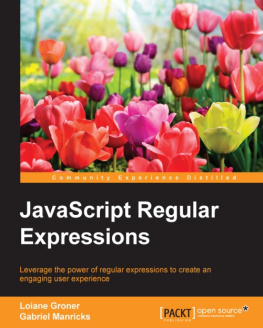Tony Stubblebine - Regular Expression Pocket Reference: Regular Expressions for Perl, Ruby, PHP, Python, C, Java and .NET
Here you can read online Tony Stubblebine - Regular Expression Pocket Reference: Regular Expressions for Perl, Ruby, PHP, Python, C, Java and .NET full text of the book (entire story) in english for free. Download pdf and epub, get meaning, cover and reviews about this ebook. year: 2007, publisher: OReilly Media, genre: Romance novel. Description of the work, (preface) as well as reviews are available. Best literature library LitArk.com created for fans of good reading and offers a wide selection of genres:
Romance novel
Science fiction
Adventure
Detective
Science
History
Home and family
Prose
Art
Politics
Computer
Non-fiction
Religion
Business
Children
Humor
Choose a favorite category and find really read worthwhile books. Enjoy immersion in the world of imagination, feel the emotions of the characters or learn something new for yourself, make an fascinating discovery.
- Book:Regular Expression Pocket Reference: Regular Expressions for Perl, Ruby, PHP, Python, C, Java and .NET
- Author:
- Publisher:OReilly Media
- Genre:
- Year:2007
- Rating:5 / 5
- Favourites:Add to favourites
- Your mark:
Regular Expression Pocket Reference: Regular Expressions for Perl, Ruby, PHP, Python, C, Java and .NET: summary, description and annotation
We offer to read an annotation, description, summary or preface (depends on what the author of the book "Regular Expression Pocket Reference: Regular Expressions for Perl, Ruby, PHP, Python, C, Java and .NET" wrote himself). If you haven't found the necessary information about the book — write in the comments, we will try to find it.
This handy little book offers programmers a complete overview of the syntax and semantics of regular expressions that are at the heart of every text-processing application. Ideal as a quick reference, Regular Expression Pocket Reference covers the regular expression APIs for Perl 5.8, Ruby (including some upcoming 1.9 features), Java, PHP, .NET and C#, Python, vi, JavaScript, and the PCRE regular expression libraries.
This concise and easy-to-use reference puts a very powerful tool for manipulating text and data right at your fingertips. Composed of a mixture of symbols and text, regular expressions can be an outlet for creativity, for brilliant programming, and for the elegant solution. Regular Expression Pocket Reference offers an introduction to regular expressions, pattern matching, metacharacters, modes and constructs, and then provides separate sections for each of the language APIs, with complete regex listings including:
- Supported metacharacters for each language API
- Regular expression classes and interfaces for Ruby, Java, .NET, and C#
- Regular expression operators for Perl 5.8
- Regular expression module objects and functions for Python
- Pattern-matching functions for PHP and the vi editor
- Pattern-matching methods and objects for JavaScript
- Unicode Support for each of the languages
Tony Stubblebine: author's other books
Who wrote Regular Expression Pocket Reference: Regular Expressions for Perl, Ruby, PHP, Python, C, Java and .NET? Find out the surname, the name of the author of the book and a list of all author's works by series.













